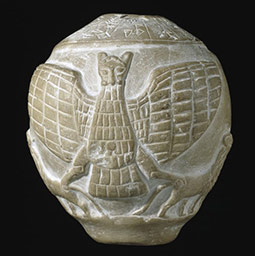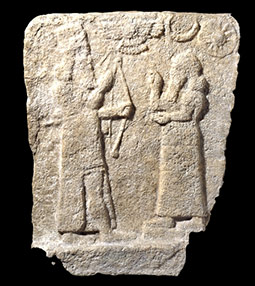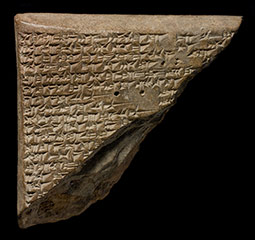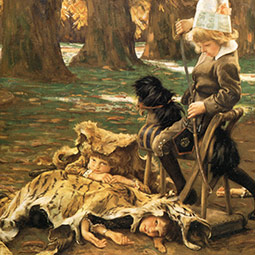Ninurta, god of victory
Ninurta, god of victory, occupied a splendid temple right next to the royal palace. It was one of the first of Kalhu's buildings to be completed, reflecting this deity's importance for Assyrian kingship. But as mythical rescuer of the Tablet of Destinies from the evil Anzu bird, he also had a link to scholarly life. Ninurta may also be the origin of the modern site-name Nimrud.
Mythical hero, conquerer of chaos: Ninurta and the Tablet of Destinies
In Babylonia, people had worshipped Ninurta since at least the mid-third millennium BC (Image 1). His main temple, Ešumeša PGP , was in the Babylonian city of Nippur PGP . There in the south he was primarily a deity of agriculture and son of the great god Ellil PGP (1), (2). Many myths and hymns described how he overcame forces of chaos to bring order, and farming, to the natural world.
Three of them were widely copied in Assyria too.
- Ninurta's Exploits (Lugale)
- This Sumerian-language composition recounts Ninurta's defeat of the Azag PGP demon and its stone army, with the help of his trusty mace. The victory enables him to bring about agriculture and to commission fates for the conquered stones, assigning them roles—for good or bad—in the world. He returns to his home city of Nippur to great acclaim and celebration (3).
- Ninurta's Exploits is a modern title. In Sumerian this work was known as Lugale, "O king!", after its opening word. By Assyrian times it had acquired a line-by-line Akkadian TT translation, as Sumerian was considered to be increasingly hard to understand.
- Ninurta's Return to Nippur (Angim dimma)
- This Sumerian-language companion piece to Ninurta's Exploits focuses, as the modern title suggests, on the god's victorious return to his city. It is more a hymn of praise than a narrative work. Its ancient title, Angim dimma, "Created like the god An", gives a flavour of the exuberant similes employed. It too gained an Akkadian translation in the first millennium BC (4).
- Anzu
- This Akkadian-language myth is very similar in structure to Ninurta's Exploits and, like it and Ninurta's Return, had been in circulation since at least the early second millennium BC. In three chapters it describes how Ninurta heroically overcomes the evil Anzu bird PGP , who has stolen the gods' Tablet of Destinies TT from Ellil PGP . Anzu cunningly uses the Tablet of Destinies' powers over the future to turn back time, disassembling the god's arrows into their constituent parts. Eventually Ninurta tricks Anzu into defeat and brings back the Tablet of Destinies to its rightful owner, to much rejoicing. The composition is described in more detail on the GKAB project's website.
Anzu in particular resonated with Assyrian court scholars as it accounted for the fundamentally negotiable nature of the divinely determined future. Omens were not predictors of a fixed fate but an advance warning system of the gods' intentions for Assyria. A well judged supplication or lamentation ritual could persuade them to rewrite the Tablet of Destinies in the empire's favour. Conversely, if events did not turn out as predicted, then that was because the Tablet had been altered meanwhile.
Splendid and perfect warrior: Ninurta as supporter of Assyrian kingship
For the kings of Assyria, it was the warlike element of Ninurta's divine personality that was particularly attractive (Image 2). In the late second millennium BC there was a fashion for royal names such as Tukulti-Ninurta ("the trusted one of Ninurta"), Ninurta-apil-Ekur ("Ninurta is the heir of (Ellil's temple) Ekur"), and Ninurta-tukulti-Aššur ("Ninurta is the god Aššur's PGP trusted one"). Tukulti-Ninurta I PGP hunted fierce wild animals "at the command of the god Ninurta, who loves me", while Adad-nerari II PGP claimed to "act with the support of Aššur and the god Ninurta, the great gods, his lords, and (thereby) has felled his foes" (5).
When king Assurnasirpal II moved the Assyrian capital city to Kalhu, the first temple he built was for Ninurta. He lined its main rooms with stone slabs covered in magnificent carvings, including a striking image of Ninurta defeating the evil Anzu bird. The walls were also inscribed with a long account of his building works and military victories. Ninurta, Assurnasirpal says, is:
the strong, the almighty, the exalted, foremost among the gods, the splendid (and) perfect warrior whose attack in battle is unequalled, the eldest son who commands battle (skills), ... king of battle, the hero who rejoices in battles, the triumphant, the perfect, lord of springs and seas, the angry (and) merciless whose attack is a deluge, the one who overwhelms enemy lands (and) fells the wicked, the splendid god who never once changes, light of heaven (and) underworld who illuminates the interior of the apsû, annihilator of the evil, subduer of the insubmissive, destroyer of enemies, the one whose command none of the gods in the divine assembly can alter, bestower of life, the compassionate god to whom it is good to pray (6).
It was left to Assurnasirpal's son Shalmaneser III to complete Ninurta's ziggurat TT . His son in turn, Šamši-Adad V PGP , dedicated a monumental stone carving of himself to Ninurta, on which he recounted the military victories of his first years of rule and even before, when he quashed a rebellion against his father. None of this would have been possible, he implies, without Ninurta's support (7). And when Adad-nerari III PGP set up new endowments for the god Aššur's temple in Assur PGP they were sealed TT with Ninurta's seal as well as Aššur's (SAA 12: 1, 71).
The Assyrian kings' move from Kalhu saw a decline in Ninurta's importance, however. Sargon II PGP particularly favoured Nabu. Ninurta still counted amongst the pantheon of great gods who bestowed blessings & curses, while asû-healers blessed the king on behalf of Ninurta and the healing goddess Gula PGP (SAA 10: 314-337). The (male) prophet TT La-dagil-ili PGP twice reassured king Esarhaddon that "Your son and grandson shall rule as kings on the lap of Ninurta" (SAA 9: 1, 2). Yet an angry letter from Ninurta to an unknown king (Image 3) suggests that he and his priests were not happy with this long-term loss of status (SAA 3: 47).
Ninurta residing in Kalhu: personal piety
Even if the kings' attention turned from Ninurta in the late eighth century, the residents of the former capital city remained devoted to "Ninurta residing in Kalhu", as they called him. Legal documents regularly state that those who break contracts "shall place two minas of silver TT and one mina of gold TT in the lap of Ninurta residing in Kalhu" (e.g., SAA 6: 220). The amount of the forfeit varies but it is paid on top of a tenfold penalty to the other party and, sometimes, a quantity of tin to the city authorities. The latest known clause of this type is from 669 BC, the last year of king Esarhaddon's reign (SAA 14: 63).
Ninurta's temple in Kalhu continued to flourish right until the end of empire. It took in the unwanted and the destitute as labourers, as well as buying specialist artisans such as weavers (SAA 12: 92-94). Its cultic personnel included a šangû-priest and a chief singer with support staff including a cook, a steward, and a porter (SAA 12: 92–96; SAA 13: 128). In the late seventh century, many of these men witnessed legal documents together with their counterparts at Nabu's temple Ezida, and the two temples shared a qēpu-official.
Nimrod and Nisroch, echoes of the past
Like the rest of the city of Kalhu, Ninurta's temple fell to invaders in the late seventh century BC and was not restored. But his name was never quite forgotten. In the Book of Genesis (10:8-12), and thus in Jewish, Christian, and Muslim tradition, he lived on as Nimrod PGP the mighty hunter (Image 4). Elsewhere in the Old Testament a transcription error turned מ (Hebrew M) into ס (S), and ד (D) into ך (K or CH). Thus Nimrod turned into Nisroch PGP , deity of the temple in which king Sennacherib PGP was supposed to have been murdered (2 Kings 19:37) (8).
In due course Nimrod, Arabic Namrūd, became the name of the mound under which Ninurta's city was buried, while the stone winged genies TT that Layard PGP and his team uncovered in the 1840s were popularly known as "Nisrochs" for much of the nineteenth century. In The Story of the Amulet British author E. Nesbit PGP even has her child protagonists summon a Nisroch to help them:
'Walk forward without fear,' said Nisroch. 'Is there aught else that the Servant of the great Name can do for those who speak that name?'
'No—oh, no,' said Cyril. 'It's all right now. Thanks ever so.'
'You are a dear,' cried Anthea, not in the least knowing what she was saying. 'Oh, thank you thank you. But DO go NOW!'
She caught the hand of the creature, and it was cold and hard in hers, like a hand of stone.
'Go forward,' said Nisroch. And they went (9).
Even now the names and martial, macho reputations of Nisroch and Nimrod live on in contexts as various as classical music, aircraft design, and popular satire. Most recently Ninurta's evil foe Anzu has had a dinosaur named after him.
Content last modified: 18 Dec 2019
References
- Streck, M.P., 1998-2001. "Ninurta/Ningirsu. A. I. In Mesopotamien", in D.O. Edzard and M.P. Streck (eds.), Reallexikon der Assyriologie 9, Berlin: Walter de Gruyter, pp. 512-522. (Find in text ^)
- Wiggermann, F.A.M., 2011. "Agriculture as civilization: sages, farmers, and barbarians", in K. Radner and E. Robson (eds.), The Oxford Handbook of Cuneiform Culture, Oxford: Oxford University Press, pp. 663-689. (Find in text ^)
- Black, J.A. et al., 2004. The Literature of Ancient Sumer, Oxford: Oxford University Press, pp. 163-180. (Find in text ^)
- Black, J.A. et al., 2004. The Literature of Ancient Sumer, Oxford: Oxford University Press, pp. 181-186. (Find in text ^)
- Grayson, A.K., 1991. Assyrian Rulers of the Early First Millennium BC: I (1114-859 BC) (Royal Inscriptions of Mesopotamia. Assyrian Periods. Volume 2), Toronto: University of Toronto Press, pp. 25-26, A.0.87.1; 143, A.0.99.1. (Find in text ^)
- Grayson, A.K., 1991. Assyrian Rulers of the Early First Millennium BC: I (1114-859 BC) (Royal Inscriptions of Mesopotamia. Assyrian Periods. Volume 2), Toronto: University of Toronto Press, pp. 193-4 A.0.101.1. (Find in text ^)
- Grayson, A.K., 1996. Assyrian Rulers of the Early First Millennium BC II (858-745 BC) (Royal Inscriptions of Mesopotamia. Assyrian Periods. Volume 3), Toronto: University of Toronto Press, pp. 182 A.0.103.1. (Find in text ^)
- Toorn, K. van der and P.W. van der Horst, 1990. "Nimrod before and after the Bible", The Harvard Theological Review 83, pp. 1-29 (PDF available via JSTOR for subscribers). (Find in text ^)
- Nesbit, E., 1906. The Story of the Amulet, London: T. Fisher Unwin, p. 112. (Find in text ^)
Eleanor Robson
Eleanor Robson, 'Ninurta, god of victory', Nimrud: Materialities of Assyrian Knowledge Production, The Nimrud Project at Oracc.org, 2019 [http://oracc.museum.upenn.edu/nimrud/ancientkalhu/thepeople/ninurta/]



